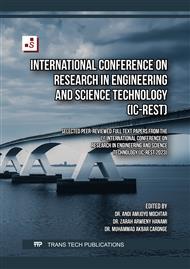[1]
J. S. Cabrera and H. S. Lee, "Flood risk assessment for Davao Oriental in the Philippines using geographic information system-based multi-criteria analysis and the maximum entropy model," J Flood Risk Manag, vol. 13, no. 2, Jun. 2020.
DOI: 10.1111/jfr3.12607
Google Scholar
[2]
A. Purwanto, Rustam, Eviliyanto, and D. Andrasmoro, "Flood Risk Mapping Using GIS and Multi-Criteria Analysis at Nanga Pinoh West Kalimantan Area," Oct. 13, 2022, Gadjah Mada University.
DOI: 10.22146/IJG.69879
Google Scholar
[3]
H. Rakuasa, J. K. Helwend, and D. A. Sihasale, "Pemetaan Daerah Rawan Banjir di Kota Ambon Menggunakan Sistim Informasi Geografis," Jurnal Geografi : Media Informasi Pengembangan dan Profesi Kegeografian, vol. 19, no. 2, p.73–82, Dec. 2022.
DOI: 10.15294/jg.v19i2.34240
Google Scholar
[4]
BNPB, "Kajian Risiko Bencana Nasional Provinsi Sulawesi Selatan 2022 – 2026," 2022.
Google Scholar
[5]
F. Monger, D. V Spracklen, M. J Kirkby, and L. Schofield, "The impact of semi-natural broadleaf woodland and pasture on soil properties and flood discharge," Hydrol Process, vol. 36, no. 1, Jan. 2022.
DOI: 10.1002/hyp.14453
Google Scholar
[6]
S. R. Bajracharya, N. R. Khanal, P. Nepal, S. K. Rai, P. K. Ghimire, and N. S. Pradhan, "Community assessment of flood risks and early warning system in Ratu watershed, Koshi basin, Nepal," Sustainability (Switzerland), vol. 13, no. 6, Mar. 2021.
DOI: 10.3390/su13063577
Google Scholar
[7]
I. Madani, S. Bachri, and S. Aldiansyah, "Pemetaan Kerawanan Banjir di Daerah Aliran Sungai (DAS) BENDO Kabupaten Banyuwangi Berbasis Sistem Informasi Geografis," Jurnal Geosaintek, vol. 8, no. 2, p.2502–3659, May 2022.
DOI: 10.12962/j25023659.v8i2.11907
Google Scholar
[8]
K. Seejata, A. Yodying, T. Wongthadam, N. Mahavik, and S. Tantanee, "Assessment of flood hazard areas using Analytical Hierarchy Process over the Lower Yom Basin, Sukhothai Province," in Procedia Engineering, Elsevier Ltd, 2018, p.340–347.
DOI: 10.1016/j.proeng.2018.01.044
Google Scholar
[9]
C. Khoeun et al., "Assessing Flood Hazard Index using Analytical Hierarchy Process (AHP) and Geographical Information System (GIS) in Stung Sen River Basin," in IOP Conference Series: Earth and Environmental Science, Institute of Physics, 2022.
DOI: 10.1088/1755-1315/1091/1/012031
Google Scholar
[10]
H. Rakuasa and P. C. Latue, "Spatial Analysis of Flood Problem Area in Wae Heru Watershed, Ambon City," Jurnal Tanah dan Sumberdaya Lahan, vol. 10, no. 1, p.75–82, Jan. 2023.
DOI: 10.21776/ub.jtsl.2023.010.1.8
Google Scholar
[11]
E. Tamburaka and H. Hasddin, "Tingkat Kerawanan dan Arahan Pengendalian Pengurangan Risiko Bencana Banjir di Kecamatan Mandonga, Kota Kendari," Jurnal Pembangunan Wilayah & Kota, vol. 17, no. 2, p.137–148, Jun. 2021.
DOI: 10.14710/pwk.v17i2.32385
Google Scholar
[12]
J. Junivan, L. Linawati, and I. A. D. Giriantari, "Analisis Potensi Banjir di Kota Denpasar Menggunakan Metode Analytical Hierarchy Process," Majalah Ilmiah Teknologi Elektro, vol. 17, no. 2, p.227, Sep. 2018.
DOI: 10.24843/mite.2018.v17i02.p10
Google Scholar
[13]
A. Shadmehri Toosi, G. H. Calbimonte, H. Nouri, and S. Alaghmand, "River basin-scale flood hazard assessment using a modified multi-criteria decision analysis approach: A case study," J Hydrol (Amst), vol. 574, p.660–671, Jul. 2019.
DOI: 10.1016/j.jhydrol.2019.04.072
Google Scholar
[14]
S. Kittipongvises, A. Phetrak, P. Rattanapun, K. Brundiers, J. L. Buizer, and R. Melnick, "AHP-GIS analysis for flood hazard assessment of the communities nearby the world heritage site on Ayutthaya Island, Thailand," International Journal of Disaster Risk Reduction, vol. 48, Sep. 2020.
DOI: 10.1016/j.ijdrr.2020.101612
Google Scholar
[15]
D. Ramadhani and T. Hariyanto, "Application of the Analytical Hierarchy Process (AHP) Method in Mapping Flood Potentials Based on Geographic Information Systems (Study Case: Malang City, East Java)," vol. 17, no. 1, 2021.
Google Scholar
[16]
D. Rincón, U. T. Khan, and C. Armenakis, "Flood risk mapping using GIS and multi-criteria analysis: A greater toronto area case study," Geosciences (Switzerland), vol. 8, no. 8, Aug. 2018.
DOI: 10.3390/geosciences8080275
Google Scholar
[17]
S. N. Aziza, L. Somantri, and I. Setiawan, "Analisis Pemetaan Tingkat Rawan Banjir di Kecamatan Bontang Barat Kota Bontang Berbasis Sistem Informasi Geografis," Jurnal Pendidikan Geografi Undiksha, vol. 9, no. 2, p.109–120, 2021.
DOI: 10.33059/jsg.v4i2.3697
Google Scholar
[18]
Y. Liu, Z. Cui, Z. Huang, M. López-Vicente, and G. L. Wu, "Influence of soil moisture and plant roots on the soil infiltration capacity at different stages in arid grasslands of China," Catena (Amst), vol. 182, Nov. 2019.
DOI: 10.1016/j.catena.2019.104147
Google Scholar
[19]
K. Ullah and J. Zhang, "GIS-based flood hazard mapping using relative frequency ratio method: A case study of panjkora river basin, eastern Hindu Kush, Pakistan," PLoS One, vol. 15, no. 3, 2020.
DOI: 10.1371/journal.pone.0229153
Google Scholar



